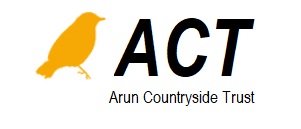 SBRS Newsletter
SBRS Newsletter
No. 81 http://www.sussexflora.org.uk January 2016
Extracts republished here by kind permission of Editor Frances Abraham
9th May 2015 Binsted Woods
(Leader: Peter Jones)
Such was the faith in the forecast of the possibility of the merest brush with a light shower that when at the start a few drops fell the party moved off confidently into Binsted Woods. A decidedly soggy hour or two later we were ticking off plants on a disintegrating recording card, but at least the bluebells were uplifting.
Peter further enhanced the proceedings by recalling Lorna Wishart, the wife of the former owner, and her romance with Laurie Lee. He also took us to the remains of her secret garden – a Camellia or two and some low stone balustrades sequestered deep in the trees. All this was nearly as poignant as the thought that the part of the woodland complex we had just recorded – Spinningwheel Copse – could be bulldozed as one of the potential routes for the A27 Arundel bypass.
Amongst a fine assemblage of ancient woodland indicators there were Orchis mascula (Early Purple-orchid) in profusion, Conopodium majus (Pignut) and the delicately waving culms of Milium effusum (Wood Millet). Having been averted in the 1990s, the threat of the bypass has returned and some members of the SBRS are helping to record the flora of the area between Binsted and Lyminster for MAVES (Mid Arun Valley Ecological Surveys). Everyone we encountered was interested in and supportive of our mission, and after lunch – when the sun had thankfully evaporated most of the accumulated damp on clothes and cards – we were invited into a parcel of land on Tortington Common to survey it for the owner.
The SBRS is not a campaigning organisation but it can through gathering data help to identify which areas are most botanically rich, so informing decision-making. Woodland on the coastal plain of Sussex is scarce after the steady clearance of centuries past, and so the Binsted-Tortington complex is especially precious.
This field meeting brought back a useful collection of records, from the ancient woodland of the western portion through to the lighter and heathier east. There was no time on this occasion to investigate the damp and sedgy rides of the part nearer to the A27. An interesting collection of plants was appreciated by the twelve members, however, including Callitriche obtusangula (Blunt-fruited Water-starwort), C. platycarpa (Various-leaved Water-starwort), Lathyrus linifolius (Bitter-vetch) and Luzula x borreri, the hybrid between L. forsteri (Southern Wood-rush) and L. pilosa (Hairy Wood-rush).
Back at the cars the thoughts of at least one person turned to where one might ask Peter to lead next year, assuming he can take time off from his new career as artisan baker and confectioner.
August 9th 2015 Danes Wood and The Rewell by Peter Jones
(Leader: Nick Sturt)
A warm, sunny morning heralded this meeting of nine members, who gathered in a quiet lane edging Danes Wood – a westerly outpost of the larger Rewell Wood or ‘The Rewell’, as many locals know it. Under the leadership of our Chairman we were tasked to find missing species within the squares SU90T and Y. The pleasant coolness of the path into the wood presently gave way to a wider, dappled ride of ruts, rushes and some persistent puddles.
Mike commenced the search for Luzula x borreri, the hybrid of L. pilosa (Hairy Wood-rush) and L. forsteri (Southern Wood-rush) and, while several candidates appeared, none was convincing until he was eventually successful and found a good example to show us before lunch. Borrer again cropped up when Steven showed us the salient points in a ‘typical specimen’ of Dryopteris borreri (Borrer’s Male-fern) which obligingly grew near similar fern species for comparison. D. affinis (Golden-scaled Male-fern), he pointed out in case we had not noticed, had an indusium ‘like a Cumberland sausage’. We wandered along rides and tracks finding our way into Rewell Wood. Mike found what appeared to be a Potentilla hybrid, P. x mixta (Hybrid Cinquefoil), which he declared had ‘good achenes’, but on consulting Stace was found to P. anglica (Trailing Tormentil).
Silver-washed fritillaries and other butterflies danced in the sunlight above the herbage in the rides. Dawn suddenly announced that we were in the vicinity of the Gnaphalium sylvaticum (Heath Cudweed) that she had discovered a few years ago. ‘I’ll just go and look for it’, she said, and pushed her way through the wall of vegetation edging the ride where we were gathered… and she vanished! She was back soon with sticks in her hair proclaiming ‘I’ve found it’. And she had – eleven excellent specimens hidden in a glade under an oak tree.
We walked along a return route hoping but failing to find Centunculus minimus (Chaffweed), which had previously been seen in ruts in this part of The Rewell. We admired the egg-like seeds of Lithospermum officinale (Common Gromwell), which someone rather poetically described as ‘jewel-like’. Returning to Danes Wood, we found a good stand of Calluna vulgaris (Heather) in flower and a large foreign interloper, Erica lusitanica (Portuguese Heath), along with a fine specimen of Cotoneaster rehderi (Bullate Cotoneaster).
We crossed what was a working gravel-pit some 30 years ago, looking in vain for Filago minima (Small Cudweed), but then a fine stand of Hieracium umbellatum attracted our attention and Mike was happy. Near the Hieracium, and watching us with a distinct expression of curiosity was a large cricket bearing a curved yellow pronotal stripe reminiscent of a broad smile which Steven told us was a Roesel’s Bush Cricket.
And so back to the waiting cars, but not without a smattering of unexpected calcicoles such Carlina vulgaris (Carline Thistle) and Blackstonia perfoliata (Yellow-wort).
